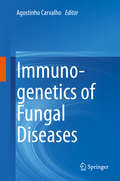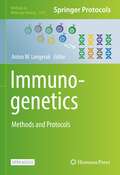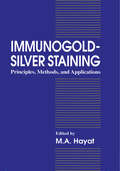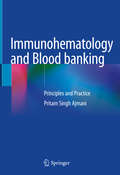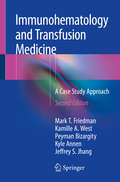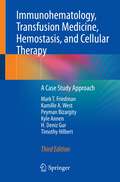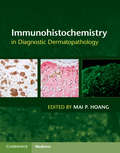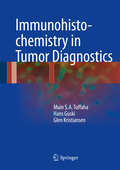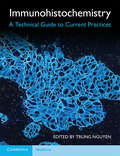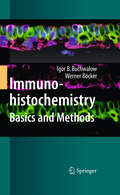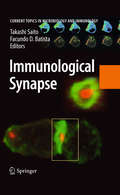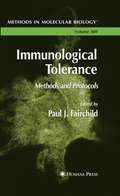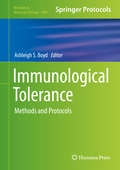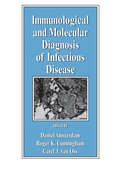- Table View
- List View
Immunogenetics of Fungal Diseases
by Agostinho CarvalhoThis book provides up-to-date information on immunogenetics of fungal diseases in the context of primary and acquired immunodeficiencies. Different aspects of this emerging field are covered, including epidemiology of fungal diseases, innate and adaptive antifungal immunity, and the role of immunogenetics in defining susceptibility to fungal diseases in primary (CMC, CGD, etc. ) immunodeficiencies and hematologic patients. The available information will also be discussed in the scope of new biomarker discovery and development of immunotherapeutic approaches for personalized diagnostics and therapy. The book addresses Professors, researchers and advanced students of Medicine, Immunology, Microbiology and Genetics.
Immunogenetics: Methods and Protocols (Methods in Molecular Biology #2453)
by Anton W. LangerakThis open access book explores techniques for working in the field of immunogenetics, i.e. fundamental and translational research into the adaptive immune receptor repertoire. Many chapters are dedicated to lab protocols, bioinformatics, and immunoinformatics analysis of high-resolution immunome analysis, exemplified by numerous applications. Additionally, the newest technological variations on these protocols are discussed, including non-amplicon, single-cell, and cell-free strategies. Written for the highly successful Methods in Molecular Biology series, chapters include introductions to their respective topics, lists of the necessary materials and reagents, step-by-step, readily reproducible laboratory protocols, and tips on troubleshooting and avoiding known pitfalls. Authoritative and practical, Immunogenetics: Methods and Protocols covers a broad spectrum of methodologies for applications in research and clinical diagnostics to illustrate the impact that immunogenetics has achieved and will further expand in all fields of medicine, from infection and (auto)immunity, to vaccination, to lymphoid malignancy and tumor immunity.
Immunogold-Silver Staining: Principles, Methods, and Applications
by M. A. HayatThis book discusses the principles, methods, and applications of immunogold-silver staining (IGSS) to biomedical areas. It focuses on the latest advances in the dynamic and progressive field of IGSS.
Immunohematology and Blood banking: Principles and Practice
by Pritam Singh AjmaniThe book covers the basics of genetics and immunology, technical aspects of blood banking and transfusion.It offers a concise, and practical approach for different blood tests and guidelines on the best ways to take donor history, screen donors, store blood components, ensure safety, and anticipate the potentially adverse effects of blood transfusion, components and its management at the bedside. Different chapters include important topics such as collection, storage and transportation of blood, introduction to blood transfusion, blood group serology, discovery of blood groups, donor selection, interview, and its preparation, and storage, pretransfusion testing, transfusion therapy, clinical considerations, and safety, quality assurance, and data management developed specifically for medical technologists and resident doctors. The book also goes beyond preoperative patient blood management, with detailed accounts of coagulation disorder management and the administration of coagulation products and platelet concentrates. The book also defines the components of a learning health system necessary to enable continued improvement in trauma care in both the civilian and the military sectors. This book offers a succinct and user-friendly resource with key points, boxes, tables & charts and is a quick reference guide for pathology and transfusion medicine residents and doctors in blood centers and hospitals dealing with regulatory aspects, transfusion safety, production and storage and donor care.
Immunohematology and Transfusion Medicine
by Mark T. Friedman Kamille A. West Peyman BizargityThis volume is a collection of immunohematology and transfusion medicine cases, comprised of clinical vignettes and antibody panels with questions based on each case, arranged in a workbook format. The cases are based on real patient problems which are typically encountered and covers a number of common issues and challenging problems in blood banking and transfusion practice. Discussion and resolution of each case is provided in a separate answer section, including up-to-date information on pertinent advances in the field. Written by experts in the field, Immunohematology and Transfusion Medicine: A Case Study Approach provides an interactive tool to help make blood banking and transfusion medicine memorable, practical, and relevant to residents and fellows.
Immunohematology and Transfusion Medicine: A Case Study Approach
by Mark T. Friedman Kamille A. West Peyman Bizargity Kyle Annen Jeffrey S. JhangThe latest edition of this volume features an extensively revised and expanded collection of immunohematology and transfusion medicine cases, comprised of clinical vignettes and antibody panels with questions based on each case. Arranged in a workbook format, the text presents cases based on real patient problems that are typically encountered and covers a number of common issues and challenging problems in blood banking and transfusion practice. Discussion and resolution of each case is provided in a separate answer section, including up-to-date information on pertinent advances in the field. This second edition also contains new cases on topics not previously covered, including types of compatibility testing, polyagglutination, hematopoietic stem cell transplantation, immunohematology test drug interference, granulocyte transfusion, heparin-induced thrombocytopenia, and the approach to the bloodless patient.Written by experts in the field, Immunohematology and Transfusion Medicine: A Case Study Approach, Second Edition provides an interactive tool that makes blood banking and transfusion medicine memorable, practical, and relevant to residents and fellows.
Immunohematology, Transfusion Medicine, Hemostasis, and Cellular Therapy: A Case Study Approach
by Mark T. Friedman Kamille A. West Peyman Bizargity Kyle Annen H. Deniz Gur Timothy HilbertThe latest edition of this volume features an extensively revised and expanded collection of immunohematology and transfusion medicine case studies, comprised of clinical vignettes and antibody panels with questions following each case. Arranged in a workbook format, the text presents cases based on real patient problems and covers a number of common issues and challenging problems in blood banking and transfusion practice. Discussion and resolution of each case is provided in a separate answer section, including up-to-date information on pertinent advances in the field. This third edition updates information on existing case chapters and references and adds a variety of new case chapters. The enhanced title of this edition reflects upon the wider array of covered topics, including in-depth case studies of hemostasis and a second section with blood donation and cellular therapy topics. New features include a key to covered topics for each case and a case-difficulty rating scale. Written by experts in the field, Immunohematology, Transfusion Medicine, Hemostasis, and Cellular Therapy: A Case Study Approach, Third Edition is an interactive tool that makes blood banking and transfusion medicine memorable, practical, and relevant to residents, fellows, laboratory technologists, and anyone interested in gaining and updating their knowledge in the field
Immunohistochemistry and Ancillary Studies in Diagnostic Dermatopathology
by Mai P. HoangImmunohistochemistry and ancillary studies play a crucial role in diagnostic pathology. Yet, few books cover their practicality in diagnostic dermatopathology. This book provides a practical guide to the application of rapid and cost-effective immunohistochemistry, as well as ancillary studies including immunofluorescence and molecular studies. With a focus on practicality and bridging knowledge gaps, the book covers helpful diagnostic stains and pertinent ancillary studies, organized by lines of differentiation. Each chapter includes a synopsis of antibodies, immunohistochemical panels, summary tables outlining staining patterns, and case studies. Now in its second edition, this book covers entities based on lineage, including epithelial, adnexal, melanocytic, lymphoid, and soft tissue, and discusses the role of molecular studies in the diagnosis of cutaneous neoplasms and soft tissue lesions. This comprehensive volume is an essential resource for pathologists, dermatopathologists, and residents in pathology and dermatology.
Immunohistochemistry and Immunocytochemistry: Methods and Protocols (Methods in Molecular Biology #2422)
by Luis Del ValleThis volume provides a comprehensive reference guide for researchers to study the applications of labeled antibodies. Chapters guide reader through the theory and practice of immunohistochemistry, immunocytochemistry and immunofluorescence techniques. Written in the highly successful Methods in Molecular Biology series format, chapters include introductions to their respective topics, lists of the necessary materials and reagents, step-by-step, readily reproducible laboratory protocols, and useful tips on troubleshooting and avoiding known pitfalls. Authoritative and cutting-edge, Immunohistochemistry and Immunofluorescence: Methods and Protocols aims to be a useful practical guide to scientists to help further their study in this field
Immunohistochemistry in Diagnostic Dermatopathology
by Hoang Mai P.Rapid and cost-effective immunohistochemistry plays a crucial role in diagnostic pathology. However there are currently very few textbooks dedicated to its role, especially in diagnostic dermatopathology. This comprehensive volume provides a practical guide to the application of immunohistochemistry in dermatopathology and bridges the knowledge gap by updating readers with helpful diagnostic immunostains as well as recently available ones. Organized by lines of differentiation, each chapter includes a synopsis of applicable antibodies, pertinent immunohistochemical panels, summary tables outlining the staining patterns of the entities in the differential diagnosis, and case studies. The twelve chapters cover entities based on lineage including epithelial, melanocytic, lymphoid, adnexal and soft tissue. The role of immunohistochemistry as a screening test for underlying genetic syndromes, immunobullous diseases, detection of infectious agents and therapeutic purpose is also discussed in detail. This is an essential text for pathologists, dermatopathologists and residents in pathology and dermatology.
Immunohistochemistry in Tumor Diagnostics
by Muin S.A. Tuffaha Hans Guski Glen KristiansenThis book offers a comprehensive yet concise overview of immunoprofile of tumors and antibodies used in contemporary surgical pathology, and provides diagnostic algorithms for approaching tumor diagnostics.Immunohistochemistry has become the most important ancillary technique in diagnostic pathology in the last 20 years, and unlike most books on tumor diagnostics, this volume discusses in details immunohistochemical biomarkers, diagnostic approaches and their pitfalls, as well as the immunoprofile of common tumors throughout all systems of human body. With numerous color figures and detailed flowcharts, it appeals to all pathologists be they young residents in training who want a brief introduction to this technique, or specialists in need of a reliable and comprehensive reference resource in tumors diagnostics.
Immunohistochemistry in Tumor Diagnostics
by Hans Guski Glen Kristiansen Muin S.A. TuffahaThis new and updated edition provides an extensive overview of the antibodies employed in diagnostic tumor histopathology, and it presents concise summaries of the immunoprofiles of most tumors. Additionally, it offers practical diagnostic algorithms and invaluable tips to facilitate the interpretation of results.The work includes the newest available antibodies and the most recent 5th edition of the WHO classification of tumors. Furthermore, a chapter on biomarkers for theranostic applications has been added to enhance the book's utility. Designed as a practical and user-friendly bench reference for diagnostic tumor histopathology, this book is recommended to histopathologists of all levels, from aspiring residents to seasoned specialists seeking a reliable and comprehensive resource for tumor diagnostics. Moreover, it is highly recommended for oncologists, hematologists, and researchers involved in these fields.
Immunohistochemistry: A Technical Guide to Current Practices
by Trung NguyenThis book will enable practitioners to understand the many complex intricacies of immunohistochemistry (IHC) and make best use of this powerful analytical tool. Providing a thorough grounding in the fundamentals of immunohistochemistry, the book includes several chapters on robotics and automation technology, giving key information on the design of machines and tips to maximise workflow efficiencies. The relationship between IHC and molecular pathology is explained clearly, demonstrating the increasing impact on personalized medicine and targeted therapies for cancer patients. The staining protocol is deconstructed, allowing the reader to adapt it for a variety of diagnostic and research applications. Written by experts at the forefront of hospital immunohistochemistry, there is a strong emphasis on practical guidance on a range of techniques as well as troubleshooting of common problems driven by the authors' experiences. Extensively illustrated with high-quality colour images, this is an invaluable resource to all pathology practitioners utilising the technique.
Immunohistochemistry: Basics and Methods
by Igor B. Buchwalow Werner BöckerWhile many excellent texts and monographs exist which cover various aspects of immunohistochemistry, the lack of a concise comprehensive guide to using the field's methods was a major motivation for the authors to write this book. The authors carefully selected the methods and easy-to-adopt protocols discussed. In addition to estabished techniques, special attention was paid to current developments in immunohistochemistry such as antigen retrieval, signal amplification, the use of epitope tags, multiple immunolabeling, and diagnostic immunohistochemistry. All procedures examined have been tested by the authors; many are routinely used in daily practice in their institute. Each chapter starts with a short introduction to the respective method's underlying principles before presenting step-by-step protocols and instructions, including precise recipes for all materials needed. Thus, the book is suitable for a broad audience, ranging from students and technical assistants to experienced researchers.
Immunoinformatics
by Darren R. FlowerThis volume both engages the reader and provides a sound foundation for the use of immunoinformatics techniques in immunology and vaccinology. It addresses databases, HLA supertypes, MCH binding, and other properties of immune systems. The book contains chapters written by leaders in the field and provides a firm background for anyone working in immunoinformatics in one easy-to-use, insightful volume.
Immunoinformatics
by Rajat K. De Namrata TomarAt the intersection of experimental and computational sciences, the second edition of Immunoinformatics provides biological insights as well as a simpler way to implement approaches and algorithms in the immunoinformatics research domain. After an introductory section, this extensive volume moves on to cover topics such as databases, tools for prediction, systems biology approaches, as well as a variety of immunoinformatics applications. As part of the highly successful Methods in Molecular Biology series, chapters include the type of detailed information and implementation advice to ensure successful results. Comprehensive and practical, Immunoinformatics, Second Edition aims at students and researchers from diverse backgrounds and levels interested in working with immunological problems.
Immunoinformatics (Methods in Molecular Biology #2131)
by Namrata TomarThis book covers a wide range of diverse immunoinformatics research topics, involving tools and databases of potential epitope prediction, HLA gene analysis, MHC characterizing, in silico vaccine design, mathematical modeling of host-pathogen interactions, and network analysis of immune system data. In that way, this fully updated volume explores the enormous value of computational tools and models in immunology research. Written for the highly successful Methods in Molecular Biology series, chapters include the kind of key insights and detailed implementation advice to encourage successful results in the lab. Authoritative and practical, Immunoinformatics, Third Edition serves as an ideal guide for scientists working at the intersection of bioinformatics, mathematical modelling, and statistics for the study of immune systems biology.
Immunologic Signatures of Rejection
by Francesco M. Marincola Ena WangThis book discusses the mechanisms leading to immune-mediated tissue rejection following the hypothesis that independent of the disease process the final effector mechanism is shared by most (but not all) pathologies and it is relatively simple. The book covers evidence gathered to support the thesis by studies performed in humans during rejection or in experimental models and will focus particularly (but not exclusively) on the analysis of the rejected tissue rather than the systemic circulation. Several disease processes are discussed including example of chronic inflammatory process without resolution of the pathologic process and acute one with resolution of the pathologic process (clearance of pathogen, rejection of tumor) or unwanted tissue destruction (allograft rejection, autoimmunity).
Immunological Mechanisms and Therapies in Brain Injuries and Stroke
by John H. Zhang Jun Chen Xiaoming Hu Mary Stenzel-PooreRecent research has revealed the importance of immunological mechanisms and inflammation in delaying damage and/or promoting repair after an acute injury to the central nervous system. This book provides a comprehensive and up-to-date overview of the role of immunological mechanisms and therapies for treating acute neurological injuries such as cerebral ischemia, hemorrhage, and brain and spinal cord trauma. In several sections, the contributing authors provide a review of immunological mechanisms involved in neurological injury and of various translational and clinical research aimed at harnessing those mechanisms for better patient outcomes.
Immunological Synapse
by Takashi Saito Facundo D. BatistaWhile the importance of the immune synapse as a dynamic cell junction that regulates intercellular communication and viral transmission is universally recognized, many of quantitative and qualitative details remain unsettled. The plasticity of this cell junction has to accommodate many very different binding partners and control the fate of interacting cells. It is likely that developmental changes in the state of the T cells or the APCs can impact the structure of the synapse. It is hoped that uncovering the ordered molecular rearrangement at the membrane will provide the long sought after clues for the remarkable functional sensitivity of T lymphocytes. These dynamic molecular interactions may eventually explain how engagement of the same TCR can generate different outcomes that resolve the immune challenges. The reviews in this issue present a broad slice of the many diverse topics that are currently intensely debated.
Immunological Tolerance
by Paul J. FairchildImmunological Tolerance: Methods and Protocols is a comprehensive guide to the techniques currently used for culturing and characterising the cell types responsible for imposing self-tolerance and the experimental models employed to study their function both in vitro and in vivo. This guide is aimed at AIDS researchers, immunologists, transplant surgeons/specialists, and biotechnologists.
Immunological Tolerance: Methods and Protocols (Methods in Molecular Biology #1899)
by Ashleigh S. BoydThis edition provides a detailed, up-to-date overview of methods used in the field of immune tolerance. Chapters guide readers through tolerogenic cell types, isolating tolerogenic cell populations for study and therapeutic utility, multiple methods to study the mechanisms underpinning tolerance, methods to induce tolerance through thymus progenitors, and methods to assess the breakdown of immune tolerance in specific pathological conditions. Written in the highly successful Methods in Molecular Biology series format, chapters include introductions to their respective topics, lists of the necessary materials and reagents, step-by-step, readily reproducible laboratory protocols, and tips on troubleshooting and avoiding known pitfalls. Authoritative and cutting-edge, Immunological Tolerance: Methods and Protocols aims to ensure successful results in the further study of this vital field.
Immunological and Molecular Diagnosis of Infectious Disease
by Carel J. van OssWritten by world-renowned experts, this book addresses immunological and molecular methodologies of diagnosis as well as clinical aspects of diseases. It book discusses DNA and RNA amplification methods, explains ELISA approaches, and introduces rapid diagnosis techniques, biosensors, and flow cytometry. The book examines bacterial and parasitic in
Immunologie fur Dummies (Für Dummies)
by Bärbel HäckerVom Antigen bis zur Zyto - toxizität – alles, was Sie über Immunologie wissen müssen Unser Immunsystem ist komplex – zum Glück für uns als Menschen, aber auch zum Leidwesen der Studenten, die sich mit Immunologie beschäftigen. Bärbel Häcker hilft Ihnen, sich dieser Materie zu nähern. Leicht verständlich erklärt sie die Komponenten des Immunsystems sowie die zelluläre und die humorale Immunantwort. Sie erläu - tert, was Sie über die Mediatoren und die anderen Proteine im Immunsystem wissen sollten und vieles mehr. Dieses Buch ist ein Wegweiser für jeden, der sich in dem Labyrinth aus Makrophagen, Lymphozyten und Granulo - zyten zurechtfinden muss. So können Sie der nächsten Klausur entspannt entgegensehen.
Immunologie für Dummies (Für Dummies)
by Bärbel HäckerUnser Immunsystem ist vielschichtig. Das ist gut für unsere Gesundheit, macht es Studierenden aber schwer, Immunologie zu lernen. Bärbel Häcker hilft Ihnen, sich der Materie zu nähern. Leicht verständlich erklärt sie die Komponenten des Immunsystems sowie die zelluläre und die humorale Immunantwort. Sie erläutert, was Sie über die Mediatoren und die anderen Proteine im Immunsystem wissen sollten und vieles mehr. So ist dieses Buch ein Wegweiser für jeden, der sich in dem Labyrinth aus Makrophagen, Lymphozyten und Granulozyten zurechtfinden muss. So begleitet, können Sie der nächsten Klausur entspannt entgegensehen.
